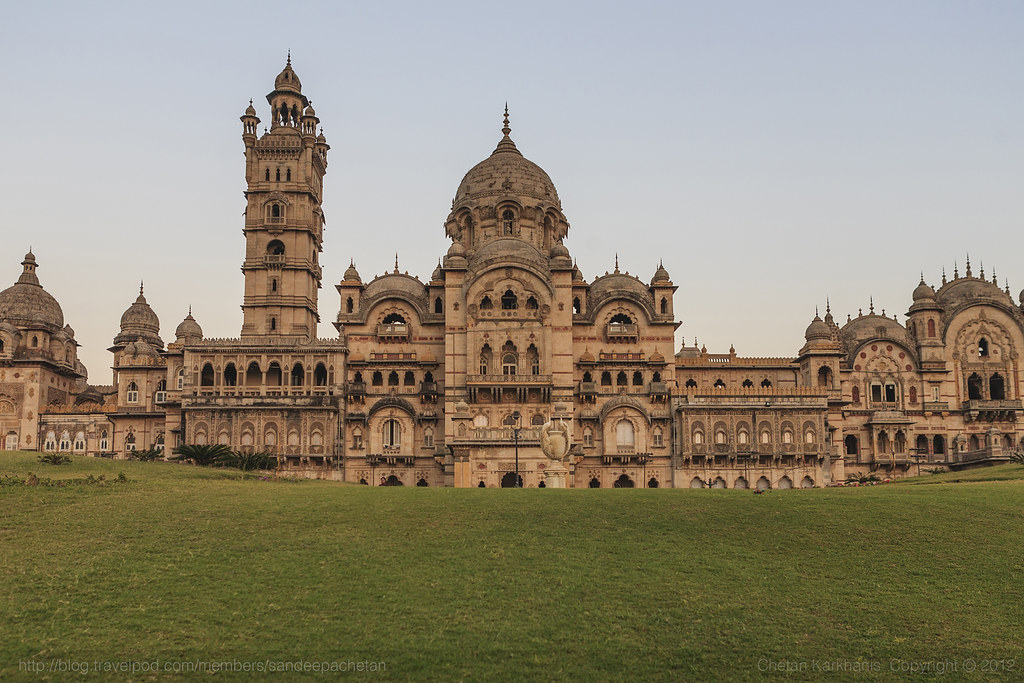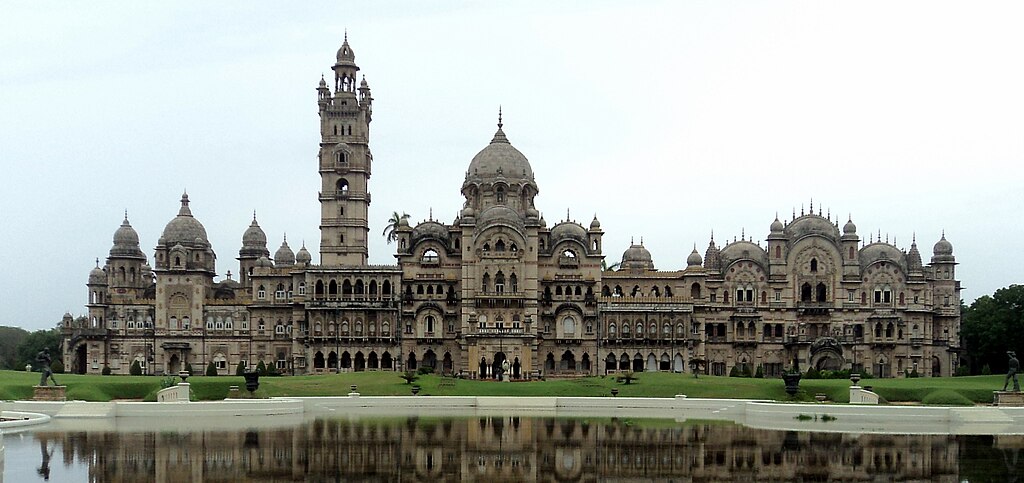Laxmi Vilas Palace, Vadodara: A Majestic Heritage

Laxmi Vilas Palace in Vadodara, Gujarat, is a magnificent symbol of opulence and architectural grandeur. Built in 1890 by Maharaja Sayajirao Gaekwad III, the palace is a testament to the rich history and cultural heritage of the Gaekwad dynasty. With its Indo-Saracenic architecture, the palace stands as a stunning amalgamation of Indian, Islamic, and European styles, making it one of the most impressive royal residences in the world.
Architectural Marvel

Laxmi Vilas Palace is four times the size of Buckingham Palace, spreading over 500 acres. Designed by Major Charles Mant, the palace features a blend of architectural elements, including Venetian, Gothic, and Indo-Saracenic styles. Its elaborate interiors are adorned with mosaic decorations, intricate chandeliers, and ornate marble work. The palace’s façade is equally captivating, with its domes, turrets, and arches creating a picturesque view.
Key Features
- Darbar Hall: The grand Darbar Hall, with its Venetian mosaic floors, Belgian stained glass windows, and ornate decorations, is a highlight of the palace. It served as the venue for royal gatherings and public events.
- Museum: Part of the palace has been converted into a museum, showcasing a vast collection of artifacts, including paintings, sculptures, and ancient weaponry. The museum also features works by renowned artists like Raja Ravi Varma, reflecting the cultural richness of the era.
- Golf Course: The sprawling estate includes a 10-hole golf course, adding to the leisure and luxury of the palace grounds. It is a popular spot for both locals and tourists.
- Gardens and Fountains: The beautifully landscaped gardens, adorned with fountains and sculptures, enhance the palace’s grandeur. They provide a serene environment, perfect for leisurely strolls and appreciating the architectural beauty.
Historical Significance
The Gaekwad Dynasty
The Gaekwad dynasty ruled Baroda (now Vadodara) for over two centuries, with Maharaja Sayajirao Gaekwad III being one of its most illustrious rulers. Under his reign, the state witnessed significant reforms in education, health, and infrastructure. The construction of Laxmi Vilas Palace marked a new era of modernization and cultural patronage.
Vision of Maharaja Sayajirao Gaekwad III
Maharaja Sayajirao Gaekwad III was a visionary ruler who sought to blend traditional Indian values with modern advancements. He envisioned Laxmi Vilas Palace as not only a royal residence but also a cultural hub. His commitment to education and social welfare is reflected in various initiatives, including the establishment of the Baroda College and the Maharaja Sayajirao University.

Cultural and Social Contributions
Patronage of Arts
The Gaekwad dynasty, particularly under Sayajirao Gaekwad III, was known for its patronage of the arts. The palace itself is a repository of artistic treasures, with paintings by renowned artists, intricate murals, and exquisite sculptures. The maharaja’s support extended to artists, musicians, and writers, making Vadodara a thriving cultural center.
Educational Reforms
Maharaja Sayajirao Gaekwad III was a strong advocate for education. He established numerous schools and colleges, promoting both traditional and modern education. His efforts in female education were particularly noteworthy, as he introduced scholarships and programs to empower women through education.
Social Welfare
The maharaja’s contributions to social welfare included reforms in agriculture, healthcare, and public administration. He introduced measures to improve irrigation, promote industrialization, and provide healthcare facilities, significantly enhancing the quality of life for his subjects.
Visitor Experience
Guided Tours
Visitors to Laxmi Vilas Palace can explore its opulent interiors through guided tours. These tours provide insights into the palace’s history, architecture, and the lifestyle of the royal family. The knowledgeable guides offer engaging narratives, making the visit informative and enjoyable.
Sound and Light Show
The palace also hosts a sound and light show in the evenings, narrating the history of the Gaekwad dynasty and the palace’s architectural splendor. This immersive experience highlights the cultural richness of Vadodara and the legacy of the Gaekwads.
Heritage Walks
The sprawling estate offers heritage walks, allowing visitors to explore the lush gardens, golf course, and surrounding areas. These walks provide a glimpse into the grandeur of royal life and the natural beauty of the palace grounds.
Events and Celebrations
Cultural Events
Laxmi Vilas Palace serves as a venue for various cultural events and festivals, celebrating the rich traditions of Gujarat. These events include music concerts, art exhibitions, and traditional dance performances, attracting both locals and tourists.
Royal Weddings
The palace is a popular destination for royal weddings and grand celebrations. Its regal ambiance, combined with modern amenities, makes it an ideal venue for memorable occasions. The intricate architecture and lush gardens provide a stunning backdrop for weddings and events.
Preservation and Legacy
Conservation Efforts
Efforts are underway to preserve the architectural and cultural heritage of Laxmi Vilas Palace. Conservation projects focus on maintaining the palace’s structural integrity, restoring its intricate artworks, and safeguarding its historical artifacts. These initiatives ensure that future generations can continue to appreciate the palace’s splendor.
Role in Tourism
Laxmi Vilas Palace plays a significant role in promoting tourism in Vadodara. It attracts visitors from across the globe, contributing to the local economy and enhancing the city’s cultural profile. The palace’s historical and architectural significance makes it a must-visit destination in Gujarat.
Visit Laxmi Vilas Palace
Laxmi Vilas Palace is more than just a royal residence; it is a testament to the rich cultural heritage and history of Gujarat. Its architectural grandeur, combined with the visionary legacy of Maharaja Sayajirao Gaekwad III, makes it a symbol of Vadodara’s glorious past. The palace continues to inspire awe and admiration, drawing visitors into a world of opulence, art, and history. Whether exploring its magnificent halls, strolling through its gardens, or attending cultural events, a visit to Laxmi Vilas Palace is a journey into the heart of Gujarat’s royal heritage.
How to Reach Laxmi Vilas Palace?
By Air Vadodara is well-connected by domestic flights to major cities like Ahmedabad, Delhi, Mumbai, Daman, and Pune. The airport is conveniently located and offers various flight options for travelers.
By Train As a major railway junction on the Western Railway, Vadodara connects Mumbai, Delhi, and Ahmedabad. Frequent trains make it easily accessible, making rail travel a popular choice.
By Road Located 112 km from Ahmedabad and 420 km from Mumbai, Vadodara is on National Highway 8. State transport buses and private luxury coaches connect Vadodara to destinations across Gujarat, Maharashtra, Madhya Pradesh, Delhi, and Rajasthan. Ahmedabad-Vadodara intercity buses run every 15 minutes and take about 2 hours. Private bus companies are also available near Station Road, with ticket prices averaging around ₹100 to Ahmedabad and ₹200 to Mumbai. Renting a car with a driver is another option for exploring the city and its surroundings.
Photos: Wiki/internet


